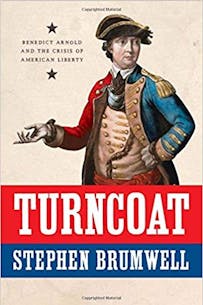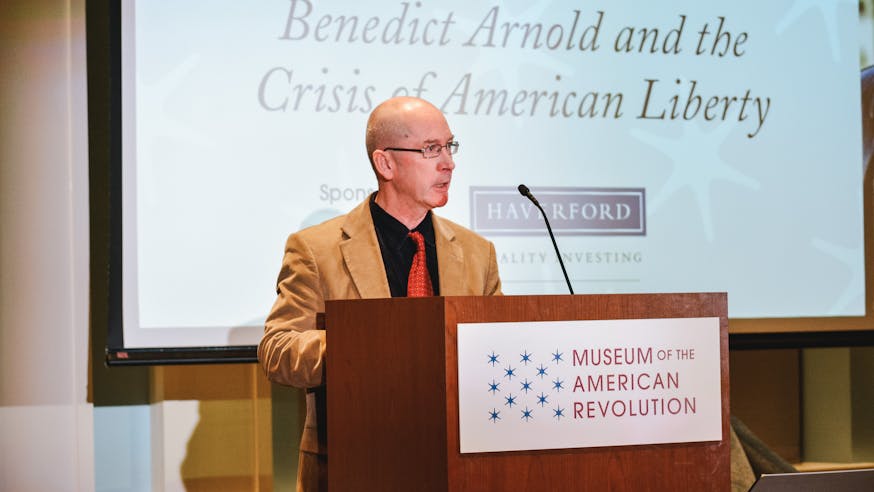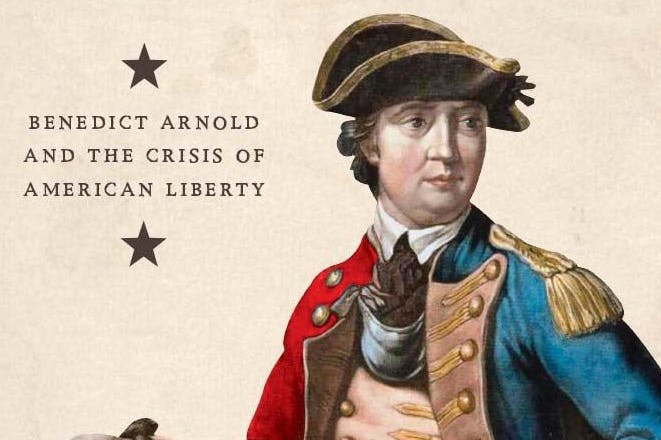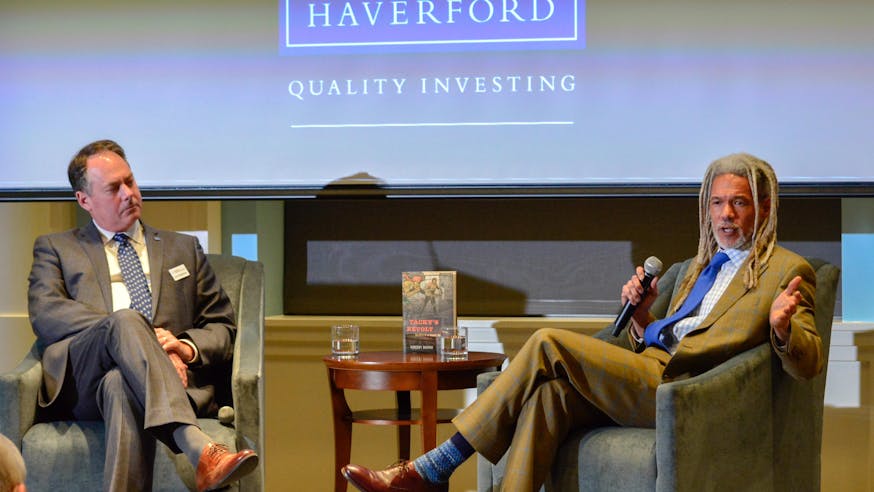Read the Revolution
Turncoat
January 22, 2020
Purchase the book from the Museum Shop.
Benedict Arnold has fascinated Americans for two centuries. The drama surrounding one of the Continental Army’s most accomplished generals defecting to the British Army makes a good story that has been told in books, films, and recently on television. Historian Stephen Brumwell’s new research into Arnold’s life, his letters, and the writings of his contemporaries has yielded the latest study of America’s most famous traitor. Turncoat: Benedict Arnold and the Crisis of American Liberty, published in 2018, provides a fresh perspective on Arnold’s personality and his sense of honor.
The city of Philadelphia played an important role in Arnold’s turn-of-coat. In 1778, he took up his post as the Continental Army’s commandant of the city but faced issues throughout his tenure. For example, Arnold developed a conflict with Pennsylvania’s Supreme Executive Council over the balance of power between military and civilian authority. His personal spending habits and relationships with Loyalists in the city also caught the negative attention of Joseph Reed, a former aide-de-camp to General Washington. Perhaps most importantly, Philadelphia is the place where Arnold’s courtship of the young Peggy Shippen began. Arnold married Shippen in her father’s home on Fourth Street on April 8, 1779. Soon after, Arnold began his secret negotiations with the British.
In the following excerpt, Brumwell examines the extent of Peggy Shippen Arnold’s influence on her husband’s decision to change sides.
Excerpt
In assessing the motivations behind Benedict Arnold’s treason, a final factor must be considered. How far did his young wife influence his actions? Once again, the timing is highly suggestive: Arnold was married on April 8, 1779; within a month he had contacted Joseph Stansbury to offer his services to Sir Henry Clinton. Under the circumstances, it’s tempting to see Peggy Arnold as a catalyst, encouraging her besotted and conflicted husband to turn to the British, or even, as some writers have argued, originating the treason herself.
Peggy Arnold was never openly accused of complicity in the plot during her own lifetime; but her friendship with British officers like John André, and the loyalist sympathies of her father, Edward Shippen, gave grounds for speculation and gossip as soon as the conspiracy was exposed. When he visited Philadelphia in December 1780, that keen observer of American life, the chevalier de Chastellux, was invited to drink tea at the house of Colonel Bland. He recorded that the “scene was graced by several married and unmarried ladies.” Among those claiming “particular distinction” was Miss Nancy Shippen, the daughter of Dr. William Shippen – and the cousin of Mrs. Peggy Arnold. Chastellux observed:
"Thus we see in America the crimes of individuals do not reflect upon their family; not only had Dr. Shippen’s brother [actually his cousin Edward] given his daughter to the traitor Arnold a short time before his desertion, but it is generally believed that being himself a Tory, he had inspired his daughter with the same sentiments, and that the charms of this handsome woman contributed not a little to hasten to criminality a mind corrupted by avarice, before it felt the power of love."
Congressman Charles Thomson had already wondered about Peggy Arnold’s hold over a man who was “brave but avaricious, fond of parade, and not very scrupulous about the means of acquiring money to defray the expenses of it.” While unconvinced of Peggy’s involvement in the plot itself, Thomson’s suspicions were aroused by her “Tory” connections. After all, he wrote, she was a “young woman who had been distinguished by General Howe’s Mischianza knights, and her father was not remarkable for attachment to the American cause.” As reported in the Pennsylvania Packet, Peggy had received correspondence from John André after the British departed Philadelphia for New York; whether there was a more sinister purpose to the letter, written “under pretense of supplying her with millinery,” Thomson could not say, and its true significance was not revealed at that time.
For a century and a half after Arnold’s defection, historians were virtually unanimous in absolving his wife of any deliberate part in his despicable crime, while also recognizing that her sympathies and social network played some role in turning him toward the British. For example, Jared Sparks considered that Arnold’s marriage “probably had a large share among the original causes” of his defection. Besides his wife’s “biases” toward such British officers as Captain André, the “alliance” brought Arnold into “perpetual contact with persons who had no sympathy with the friends of liberty… but who, on the contrary, condemned their acts, and secretly hoped that the power of the British King would crush all opposition and again predominate.” But for all that, Sparks stopped short of actually accusing Peggy herself, believing that, despite her influence on her husband, she remained oblivious to his treasonable correspondence.
For Peggy’s contemporaries, the prevailing belief that she was entirely innocent of treason was largely a consequence of her youthful beauty and engaging personality, which played on both the lustful and the chivalrous instincts of susceptible males of all ages. But it also reflected ingrained patriarchal attitudes toward women of Peggy Shippen’s refined background, who were assumed to be morally and mentally incapable of such brazen duplicity. These well-meaning but patronizing views also influenced the opinions of many nineteenth- and early twentieth-century historians. In 1865, one scholarly editor observed of Peggy: “she was, probably, unconscious of the true facts of the case, and of too light and frivolous a character, to be trusted with a plan in which silence and mystery were essential elements of success.” Clearing Peggy of any involvement in the plot, Winthrop Sargent’s 1861 biography of André lauded her “purity and elevation of character.” Writing in 1907, Albert Bushnell Hart, a professor of history at Harvard, acquitted her of any wrong-doing on the extraordinary grounds that “To be Mrs. Benedict Arnold was in itself a heavy fate, and there is no need to add the guilt of treason.”
While there is no conclusive proof that Peggy Arnold persuaded her husband to change sides, still less that she originated his treason, it is now clear that she not only knew of his designs, but was involved in the conspiracy from its inception. Her participation was first uncovered in 1941, when Carl Van Doren published papers from the headquarters of Sir Henry Clinton including André’s careful record of his interview with Stansbury. In response to a query raised during their conversation, the captain commented: “The lady might write to me at the same time with one of her intimates.” He added: “she will guess who I mean.” André would himself write to the friend, “to give occasion for a reply.” A letter that André composed soon after was addressed to Miss Peggy Chew, who had accompanied him to the Mischianza a year earlier: this leaves no doubt that “the lady” in question was Mrs. Peggy Arnold.
After apologizing to Miss Chew for failing to forward drawings of the head-dresses fashionable in New York, André casually inserted the crucial sentence:
"I trust I am yet in the memory of the little society of the Third and Fourth Street, and even of the other Peggy now Mrs. Arnold who will, I am sure, accept of my best respects and with the rest of the sisterhoods of both streets peruse not disdainfully this page meant as an assurance of my unabated esteem for them."
It is clear that André expected Peggy Chew to show his letter to Peggy Arnold. As the recipient of the captain’s letters, Peggy Chew would give her replies to Mrs. Arnold, so that they could be formally sent to André in British-occupied New York city under a flag of truce, or by an officer crossing the lines in an exchange of prisoners. Using an espionage technique known as “interlining,” André explained to Stansbury, Peggy Arnold could transform her friend’s innocent letters into valuable communications.
This method involved adding phrases in invisible ink between the lines already written by Peggy Chew; once received by André, the secret message would be “discovered” by a reactivating process, involving either flame or acid. Whether André actually sent his letter to Peggy Chew remains unclear; but as Arnold’s treason unfolded, “the lady” would play a part that the British were ready to acknowledge and reward.
Read the Revolution is sponsored by The Haverford Trust Company
Read the Revolution is published biweekly by the Museum of the American Revolution to inspire learning about the history of the American Revolution and its ongoing relevance.
Sign Up
Get biweekly Read the Revolution featured excerpts right to your inbox.
Tags
Learn More

WATCH: Read the Revolution with Stephen Brumwell

5 Pop Culture Portrayals of Benedict Arnold


